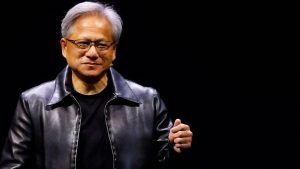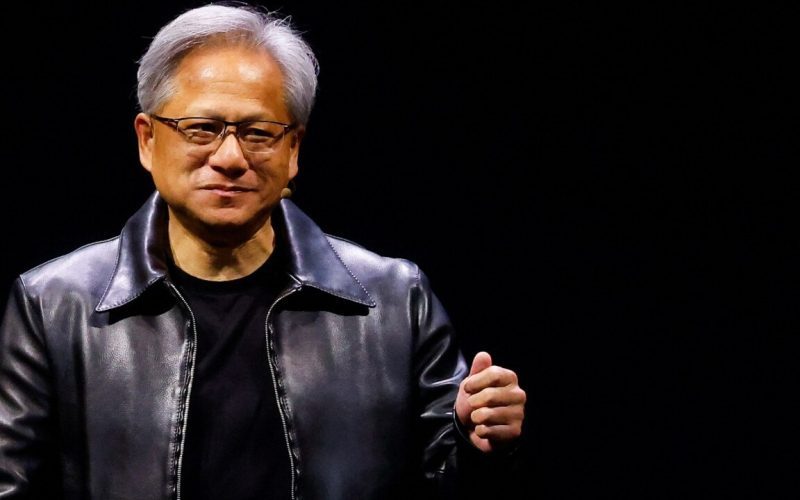Jensen Huang, the charismatic CEO and co-founder of Nvidia, has led the company to unprecedented heights, earning a reputation akin to that of Napoleon in the tech industry. Under Huang’s leadership, Nvidia has transformed from a niche graphics card producer to a dominant force in the semiconductor industry, revolutionizing areas like gaming, artificial intelligence (AI), and data centers. This article delves into Huang’s visionary leadership, Nvidia’s strategic innovations, and the company’s remarkable ascent in the tech world.
Early Life and Career of Jensen Huang

Born in Tainan, Taiwan, Jensen Huang moved to the United States with his family at a young age. He pursued electrical engineering at Oregon State University and later earned a master’s degree from Stanford University. Huang’s career began at LSI Logic and AMD, where he honed his skills and vision for the future of computing.
In 1993, Huang co-founded Nvidia with Chris Malachowsky and Curtis Priem, starting a journey that would revolutionize the graphics processing unit (GPU) industry. Huang’s technical expertise and strategic insight have been pivotal in Nvidia’s evolution from a start-up to a semiconductor giant.
Nvidia’s Transformational Innovations
Graphics Processing Units (GPUs)
Nvidia initially focused on developing high-performance GPUs for gaming and professional markets. The introduction of the GeForce series in 1999 marked a significant breakthrough, setting new standards for graphics performance and establishing Nvidia as a leader in the gaming industry. GPUs evolved from mere graphics accelerators to powerful computing engines capable of handling complex computational tasks.
Artificial Intelligence and Machine Learning
Recognizing the potential of GPUs beyond gaming, Huang steered Nvidia towards AI and machine learning. GPUs’ parallel processing capabilities made them ideal for training neural networks. Nvidia’s CUDA platform, introduced in 2006, allowed developers to harness GPU power for general-purpose computing, accelerating AI research and applications.
The development of the Nvidia Tesla series and later the Volta and Ampere architectures further cemented Nvidia’s dominance in AI. These GPUs became the backbone of data centers, supporting AI workloads from companies like Google, Amazon, and Facebook. Nvidia’s AI innovations have propelled advancements in autonomous vehicles, healthcare, and finance.
Data Centers and Cloud Computing
Nvidia’s foray into data centers and cloud computing has been another strategic masterstroke. The company’s GPUs are now integral to the infrastructure of major cloud providers, offering unparalleled performance for AI and machine learning tasks. Nvidia’s DGX systems, tailored for AI research, have become indispensable tools for organizations aiming to leverage AI for competitive advantage.
Gaming and Entertainment
While Nvidia diversified into AI and data centers, it maintained its dominance in gaming. The GeForce RTX series, with its real-time ray tracing capabilities, redefined gaming graphics, delivering unprecedented realism. Nvidia’s partnerships with game developers and console manufacturers ensured its continued relevance in the gaming industry.
Jensen Huang’s Leadership Style
Visionary Leadership
Jensen Huang’s visionary leadership is characterized by his ability to foresee industry trends and pivot Nvidia’s strategy accordingly. His foresight in recognizing the potential of GPUs for AI and data centers exemplifies his strategic acumen. Huang’s willingness to take calculated risks has positioned Nvidia as a leader in multiple high-growth markets.
Innovative Culture
Huang fosters a culture of innovation at Nvidia, encouraging experimentation and pushing the boundaries of technology. This culture has led to breakthroughs like CUDA, Tensor Cores, and the development of AI-specific hardware. Nvidia’s relentless pursuit of innovation keeps it ahead of competitors and consistently delivers cutting-edge solutions.
Resilience and Adaptability
Huang’s leadership is marked by resilience and adaptability. Nvidia has weathered market fluctuations and technological shifts under his guidance. Huang’s ability to navigate challenges, such as the cryptocurrency boom and subsequent bust, showcases his adaptability and strategic thinking.
Nvidia’s Market Performance
Financial Growth
Under Huang’s leadership, Nvidia’s financial performance has been stellar. The company’s revenue and market capitalization have soared, driven by its diversified portfolio and strategic investments in AI, data centers, and gaming. Nvidia’s stock price has reflected this growth, making it one of the most valuable semiconductor companies globally.
Strategic Acquisitions
Nvidia’s strategic acquisitions have bolstered its market position. The acquisition of Mellanox Technologies in 2019 enhanced Nvidia’s data center capabilities, while the proposed acquisition of ARM Holdings aimed to expand its reach into the CPU market. These acquisitions reflect Huang’s vision of creating a comprehensive computing platform.
Comparative Analysis
Nvidia vs. Intel
| Aspect | Nvidia | Intel |
|---|---|---|
| Core Business | GPUs, AI, Data Centers | CPUs, Data Centers |
| Market Cap (2023) | $1 trillion | $250 billion |
| Revenue (2023) | $27 billion | $79 billion |
| AI Leadership | Dominant player with CUDA and Tensor Cores | Emerging player with Habana Labs |
| Gaming Influence | Leader with GeForce series | Limited presence |
| Data Center Presence | Strong with DGX systems and Mellanox | Strong with Xeon processors |
Nvidia vs. AMD
| Aspect | Nvidia | AMD |
|---|---|---|
| Core Business | GPUs, AI, Data Centers | CPUs, GPUs |
| Market Cap (2023) | $1 trillion | $150 billion |
| Revenue (2023) | $27 billion | $23 billion |
| GPU Market Share | Leader with GeForce and Quadro | Strong contender with Radeon |
| AI Leadership | Dominant player with CUDA and Tensor Cores | Growing presence with Instinct GPUs |
| Data Center Presence | Strong with DGX systems and Mellanox | Emerging player |
Conclusion
Jensen Huang’s leadership has been instrumental in Nvidia’s transformation from a GPU manufacturer to a technology powerhouse. His strategic vision, innovative culture, and adaptability have positioned Nvidia at the forefront of multiple high-growth industries. As Nvidia continues to innovate and expand its influence in AI, data centers, and gaming, Huang’s legacy as a visionary leader in the tech industry remains firmly established. The company’s remarkable ascent under his guidance is a testament to his leadership prowess and the strategic direction he has charted for Nvidia.











